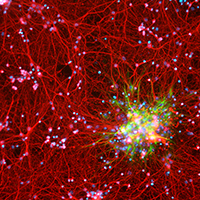Quantitative, structural and molecular changes in neuroglia of aging mammals: A review

Accepted: 27 May 2021
HTML: 11
All claims expressed in this article are solely those of the authors and do not necessarily represent those of their affiliated organizations, or those of the publisher, the editors and the reviewers. Any product that may be evaluated in this article or claim that may be made by its manufacturer is not guaranteed or endorsed by the publisher.
Authors
The neuroglia of the central and peripheral nervous systems undergo numerous changes during normal aging. Astrocytes become hypertrophic and accumulate intermediate filaments. Oligodendrocytes and Schwann cells undergo alterations that are often accompanied by degenerative changes to the myelin sheath. In microglia, proliferation in response to injury, motility of cell processes, ability to migrate to sites of neural injury, and phagocytic and autophagic capabilities are reduced. In sensory ganglia, the number and extent of gaps between perineuronal satellite cells – that leave the surfaces of sensory ganglion neurons directly exposed to basal lamina– increase significantly. The molecular profiles of neuroglia also change in old age, which, in view of the interactions between neurons and neuroglia, have negative consequences for important physiological processes in the nervous system. Since neuroglia actively participate in numerous nervous system processes, it is likely that not only neurons but also neuroglia will prove to be useful targets for interventions to prevent, reverse or slow the behavioral changes and cognitive decline that often accompany senescence.
How to Cite
PAGEPress has chosen to apply the Creative Commons Attribution NonCommercial 4.0 International License (CC BY-NC 4.0) to all manuscripts to be published.
Similar Articles
- J.H. Song, M.Y. Lee, Y.J. Kim, S.R. Park, J. Kim, S.Y. Ryu, J.Y. Jung, Developmental immunolocalization of the Klotho protein in mouse kidney epithelial cells , European Journal of Histochemistry: Vol. 58 No. 1 (2014)
- Xiangjun Lu, Jian Shen, Siyuan Huang, Dongdong Liu, Haitao Wang, Tumor cells-derived exosomal PD-L1 promotes the growth and invasion of lung cancer cells in vitro via mediating macrophages M2 polarization , European Journal of Histochemistry: Vol. 67 No. 3 (2023)
- Gianluca Accogli, Giovanni Scillitani, Donatella Mentino, Salvatore Desantis, Characterization of the skin mucus in the common octopus Octopus vulgaris (Cuvier) reared paralarvae , European Journal of Histochemistry: Vol. 61 No. 3 (2017)
- M. Riccio, E. Resca, T. Maraldi, A. Pisciotta, A. Ferrari, G. Bruzzesi, A. De Pol, Human dental pulp stem cells produce mineralized matrix in 2D and 3D cultures , European Journal of Histochemistry: Vol. 54 No. 4 (2010)
- L. Vinci, A. Ravarino, V. Fanos, A.G. Naccarato, G. Senes, C. Gerosa, G. Bevilacqua, G. Faa, R. Ambu, Immunohistochemical markers of neural progenitor cells in the early embryonic human cerebral cortex , European Journal of Histochemistry: Vol. 60 No. 1 (2016)
- Guangbao He, Yibo He, Hongwei Ni, Kai Wang, Yijun Zhu, Yang Bao, Dexmedetomidine attenuates neuroinflammation and microglia activation in LPS-stimulated BV2 microglia cells through targeting circ-Shank3/miR-140-3p/TLR4 axis , European Journal of Histochemistry: Vol. 67 No. 3 (2023)
- A.J.W. Pinto, I.F.G. de Amorim, L.J. Pinheiro, I.M.V.M. Madeira, C.C. Souza, H. Chiarini-Garcia, M.V. Caliari, W.L. Tafuri, Glycol methacrylate embedding for the histochemical study of the gastrointestinal tract of dogs naturally infected with Leishmania infantum , European Journal of Histochemistry: Vol. 59 No. 4 (2015)
- S. Strobel, J.A. Encarnação, N.I. Becker, T.E. Trenczek, Histological and histochemical analysis of the gastrointestinal tract of the common pipistrelle bat (Pipistrellus pipistrellus) , European Journal of Histochemistry: Vol. 59 No. 2 (2015)
- Nan Li, Xue Fan, Lihong Liu, Yanbing Liu, Therapeutic effects of human umbilical cord mesenchymal stem cell-derived extracellular vesicles on ovarian functions through the PI3K/Akt cascade in mice with premature ovarian failure , European Journal of Histochemistry: Vol. 67 No. 3 (2023)
- Lan Wang, Zhenyu Fan, Haijin Wang, Shougui Xiang, Propofol alleviates M1 polarization and neuroinflammation of microglia in a subarachnoid hemorrhage model in vitro, by targeting the miR-140-5p/TREM-1/NF-κB signaling axis , European Journal of Histochemistry: Vol. 68 No. 3 (2024)
<< < 1 2 3 4 5 6 7 8 9 10 > >>
You may also start an advanced similarity search for this article.

 https://doi.org/10.4081/ejh.2021.3249
https://doi.org/10.4081/ejh.2021.3249










